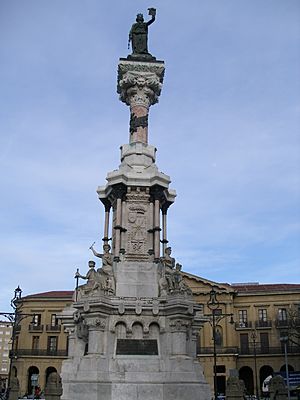Gamazada facts for kids
The Gamazada was a big protest in Navarre, Spain, during 1893 and 1894. It happened because the Spanish finance minister, Germán Gamazo, tried to change special laws called fueros. These fueros were like special rights or agreements that Navarre had, set up in 1841. When the government tried to take them away, the people of Navarre got very upset. They organized huge protests and sent many requests to the government to protect their rights.
Contents
What Caused the Protests?
The protests to protect the special fueros laws started in different parts of the Basque Country. They began in Vitoria-Gasteiz, then spread to Biscay, Navarre, and finally San Sebastián.
The finance minister, Germán Gamazo, wanted to change how Navarre and other Basque provinces paid money to the Spanish government. He proposed that these provinces should pay the same taxes as all other parts of Spain. This would have taken away their special financial agreements.
The government of Navarre officially protested this idea on May 16, 1893. Many city governments and newspapers supported this protest. A group was sent to Madrid to talk with the Prime Minister, Práxedes Mateo Sagasta, and Minister Gamazo, but they couldn't reach an agreement.
Big Demonstrations and Uproar
After the talks failed, a newspaper called El Eco de Navarra asked people to march in Navarre on May 28. The next Sunday, an even bigger march happened in Pamplona.
There was also a small, short armed protest. On the night of June 1–2, a sergeant named José López Zabalegui and a few others tried to start a revolt. They shouted "Long live the fueros!" and headed towards Arraiza. However, they were quickly stopped by the police and army. The sergeant managed to escape to France. This small event was condemned by the newspaper and the Navarrese government, who said it was an isolated act and that they did not support violence.
Even though the government didn't allow a big march for June 4, 1893, more than 17,000 people gathered anyway. People from all social classes and political groups joined in. This was the largest protest ever organized in Navarre at that time.
The leaders of Navarre asked everyone to protest peacefully against the new tax plan. But people also had other reasons for protesting, which they showed with different slogans:
- The Navarrese government's slogan was: Peace and Fueros.
- A political group called the Carlists shouted: Long live Navarre. Long live the Fueros.
- Another group, the Integristas, called for: Fueros. Compromise Law of 1841.
- Republicans said: Autonomy is the life of the peoples.
- The city of Estella-Lizarra called out: Long live the Basque-Navarrese Provinces.
The Pamplona choir sang a famous Basque song called Gernikako arbola to end the protest. More than 120,000 signatures were collected against the new law. This was a huge number, considering Navarre only had about 300,000 people then. These signatures were given to Queen Maria Christina on June 7.
The Outcome
Despite the protests, the minister's tax plan was approved by the Spanish Parliament. Only 8 members voted against it, including those from Navarre. The Navarrese government had to go back to Madrid in 1894 to try and negotiate again, but these talks also failed.
The Queen asked a general named Martínez Campos if the government should use force to make Navarre accept the new law. The general warned her that if they tried to force Navarre, it would unite with the other three Basque provinces. This could lead to a widespread uprising and even another civil war.
Luckily, Minister Gamazo had to resign from his job because of a war in Cuba. He was replaced by a new minister, Amós Salvador Rodrigáñez. The new law never actually went into effect. The new minister tried to propose a similar law in 1895, but it was never even discussed in Parliament.
The fight to protect the fueros made the people of Navarre feel even closer to the other three Basque provinces: Biscay, Araba, and Gipuzkoa. They all shared the same cause. This brought back a famous saying, Laurak bat, which means "the union of the four" or "four-in-one."
To remember this important event, many towns and cities in Navarre named streets and plazas "Fueros." In Pamplona, the people built the Monument to the Fueros. It stands as a symbol of Navarrese freedom, right in front of the Navarrese Government Building. The monument was designed by architect Manuel Martínez de Ubago and finished in 1903, but it was never officially opened.
See also
 In Spanish: Gamazada para niños
In Spanish: Gamazada para niños


